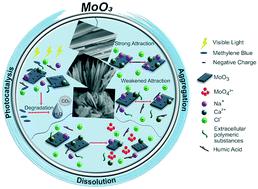当前位置:
X-MOL 学术
›
Environ. Sci.: Nano
›
论文详情
Our official English website, www.x-mol.net, welcomes your feedback! (Note: you will need to create a separate account there.)
Inorganic salts and organic matter effects on nanorod, nanowire, and nanoplate MoO3 aggregation, dissolution, and photocatalysis
Environmental Science: Nano ( IF 7.3 ) Pub Date : 2020-10-19 , DOI: 10.1039/d0en00708k Sofia K. Fanourakis 1, 2, 3, 4 , Janire Peña-Bahamonde 2, 3, 4, 5 , Debora F. Rodrigues 1, 2, 3, 4, 5
Environmental Science: Nano ( IF 7.3 ) Pub Date : 2020-10-19 , DOI: 10.1039/d0en00708k Sofia K. Fanourakis 1, 2, 3, 4 , Janire Peña-Bahamonde 2, 3, 4, 5 , Debora F. Rodrigues 1, 2, 3, 4, 5
Affiliation

|
Use of visible light photocatalytic nanomaterials in water treatment can be promising in treating contaminants. However, little research has been conducted examining the effects of more complex chemistries in the nanomaterial's performance. In this work, the effects of inorganic salts (NaCl and CaCl2) and natural organic matter (NOM) such as humic acid (HA) and extracellular polymeric substances (EPS) on nanoparticle aggregation, dissolution, and ultimately on the photocatalytic properties of molybdenum trioxide (MoO3), i.e. nanorods, nanowires, and nanoplates were examined. In the presence of NaCl, nanorod, nanowire, and nanoplate MoO3 had similar critical coagulation concentrations, while the nanorods showed higher instability in CaCl2. Overall, the presence of inorganic salts caused high colloidal instability in the MoO3 nanostructures in terms of aggregation behavior, but greatly aided in the reduction of MoO3 dissolution. NOM presence decreased aggregation rates, albeit dissolution was not similarly affected in all three structures. Only the dissolution of the nanowire structures was reduced in the presence of HA or EPS. Furthermore, the photocatalytic activity of the nanowires and nanoplates was overall reduced when inorganic salts or natural organic matter were present. While the presence of natural organic matter alone did reduce photocatalytic effectiveness of the nanorod MoO3, the presence of salts seemed to negate the effects from the organic compounds. Furthermore, the presence of CaCl2 resulted in a highly enhanced photocatalytic activity regardless of the presence of natural organic matter. The structural and chemical differences of the nanomaterials played a significant role in their aggregation, dissolution, and ability to photocatalytically degrade methylene blue in solution. This study demonstrates that a better understanding of water chemistry effects on nanomaterials is essential prior to their intended applications.
中文翻译:

无机盐和有机物对纳米棒,纳米线和纳米板MoO3聚集,溶解和光催化的影响
可见光光催化纳米材料在水处理中的应用在处理污染物方面可能很有希望。但是,很少有研究研究更复杂的化学物质对纳米材料性能的影响。在这项工作中,无机盐(NaCl和CaCl 2)和天然有机物(NOM)(如腐殖酸(HA)和细胞外聚合物(EPS))对纳米粒子聚集,溶解以及最终对钼的光催化性能的影响检验了三氧化物(MoO 3),即纳米棒,纳米线和纳米板。在NaCl,纳米棒,纳米线和纳米板MoO 3的存在下具有相似的临界凝结浓度,而纳米棒在CaCl 2中显示出更高的不稳定性。总体而言,就聚集行为而言,无机盐的存在导致MoO 3纳米结构中的高胶体不稳定性,但极大地有助于减少MoO 3的溶解。NOM的存在降低了聚集速率,尽管在这三个结构中溶解均未受到类似的影响。在HA或EPS的存在下,仅纳米线结构的溶解减少。此外,当存在无机盐或天然有机物时,纳米线和纳米板的光催化活性总体上降低。虽然仅存在天然有机物确实会降低纳米棒MoO的光催化效率如图3所示,盐的存在似乎抵消了有机化合物的影响。此外,CaCl 2的存在导致高度增强的光催化活性,而与天然有机物质的存在无关。纳米材料的结构和化学差异在它们的聚集,溶解和光催化降解溶液中亚甲基蓝的能力中起着重要作用。这项研究表明,在预期用途之前,必须更好地了解水化学对纳米材料的影响。
更新日期:2020-11-03
中文翻译:

无机盐和有机物对纳米棒,纳米线和纳米板MoO3聚集,溶解和光催化的影响
可见光光催化纳米材料在水处理中的应用在处理污染物方面可能很有希望。但是,很少有研究研究更复杂的化学物质对纳米材料性能的影响。在这项工作中,无机盐(NaCl和CaCl 2)和天然有机物(NOM)(如腐殖酸(HA)和细胞外聚合物(EPS))对纳米粒子聚集,溶解以及最终对钼的光催化性能的影响检验了三氧化物(MoO 3),即纳米棒,纳米线和纳米板。在NaCl,纳米棒,纳米线和纳米板MoO 3的存在下具有相似的临界凝结浓度,而纳米棒在CaCl 2中显示出更高的不稳定性。总体而言,就聚集行为而言,无机盐的存在导致MoO 3纳米结构中的高胶体不稳定性,但极大地有助于减少MoO 3的溶解。NOM的存在降低了聚集速率,尽管在这三个结构中溶解均未受到类似的影响。在HA或EPS的存在下,仅纳米线结构的溶解减少。此外,当存在无机盐或天然有机物时,纳米线和纳米板的光催化活性总体上降低。虽然仅存在天然有机物确实会降低纳米棒MoO的光催化效率如图3所示,盐的存在似乎抵消了有机化合物的影响。此外,CaCl 2的存在导致高度增强的光催化活性,而与天然有机物质的存在无关。纳米材料的结构和化学差异在它们的聚集,溶解和光催化降解溶液中亚甲基蓝的能力中起着重要作用。这项研究表明,在预期用途之前,必须更好地了解水化学对纳米材料的影响。


























 京公网安备 11010802027423号
京公网安备 11010802027423号